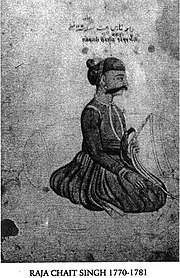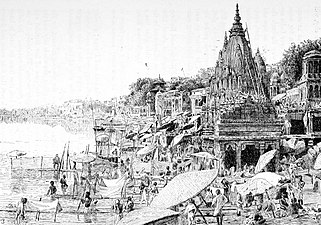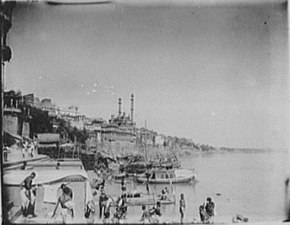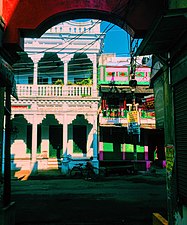
A | B | C | D | E | F | G | H | CH | I | J | K | L | M | N | O | P | Q | R | S | T | U | V | W | X | Y | Z | 0 | 1 | 2 | 3 | 4 | 5 | 6 | 7 | 8 | 9
Varanasi
Benares, Banaras, Kashi | |
|---|---|
Left to right, top to bottom: Manikarnika Ghat, the holy cremation ground on the Ganges river front; Shehnai maestro Ustad Bismillah Khan; Faculty of Arts, Benares Hindu University; Goswami Tulsidas, composer of the Ramcharitmanas; weaving silk brocade; Benares Sanskrit College, India's oldest Sanskrit college (founded in 1791); and Munshi Ghat | |
| Nickname: Religious Capital of India[1] | |
 Interactive map of Varanasi | |
| Coordinates: 25°19′08″N 83°00′46″E / 25.31889°N 83.01278°E | |
| Country | |
| State | Uttar Pradesh |
| Division | Varanasi |
| District | Varanasi |
| Government | |
| • Type | Municipal Corporation |
| • Body | Varanasi Municipal Corporation |
| • Mayor | Ashok Tiwari[3] (BJP) |
| • Municipal Commissioner | Pranay Singh, IAS |
| Area | |
| • Metropolis | 82 km2 (32 sq mi) |
| • Metro | 163.8 km2 (63.2 sq mi) |
| Elevation | 80.71 m (264.80 ft) |
| Population (2011) | |
| • Metropolis | 1,212,610[2] |
| • Rank | 30th |
| • Metro | 1,432,280 (32nd) |
| Demonym | Banarasi |
| Language | |
| • Official | Hindi[7] |
| • Additional official | Urdu[7] |
| • Regional | Bhojpuri |
| Time zone | UTC+5:30 (IST) |
| PIN | 221 001 to** (** area code) |
| Telephone code | 0542 |
| Vehicle registration | UP-65 |
| GDP | $3.8 billion (2019–20)[8] |
| Per capita income | INR 1,93 616[9] |
| International Airport | Lal Bahadur Shastri International Airport |
| Rapid Transit | Varanasi Metro |
| Sex ratio | 0.926 (2011) ♂/♀ |
| Literacy (2011) | 80.31%[10] |
| HDI | 0.812[11] |
| Website | varanasi |
Varanasi (Vārāṇasī, Hindi: [ʋaːˈraːɳəsi] ;[a] also Benares, Banaras (Banāras [bəˈnaːrəs] )[13][14][15] or Kashi (Kāshi [ˈka:ʃi] )[16]) is a city in the Indian state of Uttar Pradesh. Located on the Ganges river, it has a central place in the traditions of pilgrimage, death, and mourning in the Hindu world.[17][b] The city has a syncretic tradition of Islamic artisanship that underpins its religious tourism.[20] Located in the middle-Ganges valley in the southeastern part of the state of Uttar Pradesh, Varanasi lies on the left bank of the river. It is 692 kilometres (430 mi) to the southeast of India's capital New Delhi and 320 kilometres (200 mi) to the southeast of the state capital, Lucknow. It lies 121 kilometres (75 mi) downstream of Prayagraj, where the confluence with the Yamuna river is another major Hindu pilgrimage site.
Varanasi is one of the world's oldest continually inhabited cities.[21][22][23] Kashi, its ancient name, was associated with a kingdom of the same name of 2,500 years ago. The Lion capital of Ashoka at nearby Sarnath has been interpreted to be a commemoration of the Buddha's first sermon there in the fifth century BCE.[24][25] In the 8th century, Adi Shankara established the worship of Shiva as an official sect of Varanasi. Tulsidas wrote his Awadhi language epic, the Ramcharitmanas, a Bhakti movement reworking of the Sanskrit Ramayana, in Varanasi. Several other major figures of the Bhakti movement were born in Varanasi, including Kabir and Ravidas.[26] In the 16th century, Rajput nobles in the service of the courts and armies of the Mughal emperor Akbar, sponsored the building or further enhancement of the major Shiva temple in the city; they also built other temples, all displaying an empire-wide architectural style.[27][28] Under the Treaty of Faizabad, the Banaras Kingdom became a subordinate under the East India Company in 1775,[29][30] the city later successively becoming a part of the Benares Division in the Ceded and Conquered Provinces in 1805, the North-Western Provinces in 1836, and the United Provinces 1902, and Uttar Pradesh in 1950.[31]
Silk weaving, carpets, crafts and tourism employ a significant number of the local population, as do the Banaras Locomotive Works and Bharat Heavy Electricals. The city is known worldwide for its many ghats, steps leading down the steep river bank to the water, where pilgrims perform rituals. Of particular note are the Dashashwamedh Ghat, the Panchganga Ghat, the Manikarnika Ghat, and the Harishchandra Ghat, the last two being where Hindus cremate their dead. The Hindu genealogy registers at Varanasi are kept here. Among the notable temples in Varanasi are the Kashi Vishwanath Temple of Shiva, the Sankat Mochan Hanuman Temple, and the Durga Temple.
The city has long been an educational and musical centre: many prominent Indian philosophers, poets, writers, and musicians live or have lived in the city, and it was the place where the Benares gharana form of Hindustani classical music was developed. In the 20th-century, the Hindi-Urdu writer Premchand and the shehnai player Bismillah Khan were associated with the city. India's oldest Sanskrit college, the Benares Sanskrit College, was founded during East India Company rule in 1791. Later, education in Benares was greatly influenced by the rise of Indian nationalism in the late 19th-century. Annie Besant founded the Central Hindu College in 1898. In 1916, she and Madan Mohan Malviya founded the Banaras Hindu University, India's first modern residential university. Kashi Vidyapith was established in 1921, a response to Mahatma Gandhi's Non-cooperation movement.
Etymology
Traditional etymology links "Varanasi" to the names of two Ganges tributaries forming the city's borders: Varuna, still flowing in northern Varanasi, and Assi, today a small stream in the southern part of the city, near Assi Ghat. The old city is located on the north shores of the Ganges, bounded by Varuna and Assi.[32]
In the Mahabharata and in ancient India, the city is referred to as Kāśī (काशी: Kashi) from the Sanskrit verbal root kaś- "to shine", making Varanasi known as "City of Light",[33][16] the "luminous city as an eminent seat of learning".[34] The name was also used by pilgrims dating from Buddha's days.[citation needed]. Kashi is still widely popular.
Hindu religious texts use many epithets in Sanskrit to refer to Varanasi, such as Kāśikā (transl. "the shining one"), Avimukta (transl. "never forsaken by Shiva"), Ānandakānana (transl. "the forest of bliss"), Rudravāsa (transl. "the place where Rudra resides"), and Mahāshmashāna (transl. "the great cremation ground").[35]
History
Mythology
According to Hindu mythology, Varanasi was founded by Shiva,[36] one of three principal deities along with Brahma and Vishnu. During a conflict between Brahma and Shiva, one of Brahma's five heads was torn off by Shiva. As was the custom, the victor carried the slain adversary's head in his hand and let it hang down from his hand as an act of ignominy, and a sign of his own bravery. A bridle was also put into the mouth. Shiva thus dishonoured Brahma's head, and kept it with him at all times. When he came to the city of Varanasi in this state, the hanging head of Brahma dropped from Shiva's hand and disappeared in the ground. Varanasi is therefore considered an extremely holy site.[37]
The Pandavas, the protagonists of the Hindu epic Mahabharata, are said to have visited the city in search of Shiva to atone for their sins of fratricide and brahmahatya that they had committed during the Kurukshetra War.[38] It is regarded as one of seven holy cities (Sapta Puri) which can provide Moksha; Ayodhya, Mathura, Haridwar, Kashi, Kanchi, Avanti, and Dvārakā are the seven cities known as the givers of liberation.[39] The princesses Ambika and Ambalika of Kashi were wed to the Hastinapura ruler Vichitravirya, and they later gave birth to Pandu and Dhritarashtra. Bhima, a son of Pandu, married a Kashi princess Valandhara and their union resulted in the birth of Sarvaga, who later ruled Kashi. Dhritarasthra's eldest son Duryodhana also married a Kashi princess Bhanumati, who later bore him a son Lakshmana Kumara and a daughter Lakshmanā.[40]
The Cakkavatti Sīhanāda Sutta text of Buddhism puts forth an idea stating that Varanasi will one day become the fabled kingdom of Ketumati in the time of Maitreya.[41]
Ancient period
Excavations in 2014 led to the discovery of artefacts dating back to 800 BCE. Further excavations at Aktha and Ramnagar, two sites in the vicinity of the city, unearthed artefacts dating back to 1800 BCE, supporting the view that the area was inhabited by this time.[42]
During the time of Gautama Buddha, Varanasi was part of the Kingdom of Kashi.[43] The celebrated Chinese traveller Xuanzang, also known as Hiuen Tsiang, who visited the city around 635 CE, attested that the city was a centre of religious and artistic activities, and that it extended for about 5 kilometres (3.1 mi) along the western bank of the Ganges.[43][44] When Xuanzang visited Varanasi in the 7th century, he named it "Polonise" (婆羅痆斯) and wrote that the city had some 30 temples with about 30 monks.[45] The city's religious importance continued to grow in the 8th century, when Adi Shankara established the worship of Shiva as an official sect of Varanasi.[46]
Medieval period

Chandradeva, founder of the Gahadavala dynasty made Banaras a second capital in 1090.[47] In 1194 CE, the Ghurid conqueror Muizzuddin Muhammad Ghuri defeated the forces of Jayachandra in a battle near Jamuna and afterwards ravaged the city of Varnasi in the course of which many temples were destroyed.[48]
Varanasi remained a centre of activity for intellectuals and theologians during the Middle Ages, which further contributed to its reputation as a cultural centre of religion and education. Several major figures of the Bhakti movement were born in Varanasi, including Kabir who was born here in 1389,[49] and Ravidas, a 15th-century socio-religious reformer, mystic, poet, traveller, and spiritual figure, who was born and lived in the city and employed in the tannery industry.[50]
Early Modern to Modern periods (1500–1949)
-
A lithograph by James Prinsep of a Brahmin placing a garland on the holiest location in the city
-
A painting by Lord Weeks (1883) of Varanasi, viewed from the Ganges
-
An illustration (1890) of a bathing ghat in Varanasi
Numerous eminent scholars and preachers visited the city from across India and South Asia. Guru Nanak visited Varanasi for Maha Shivaratri in 1507,Kashi(Varansi) p that played a large role in the founding of Sikhism.[51]
In 1567 or thereabouts, the Mughal emperor Jallaludin Muhammad Akbar sacked the city of Varanasi on his march from Allahabad (modern Prayagraj).[52] However, later the Kachwaha Rajput rulers of Amber (Mughal vassals themselves) most notably under Raja Man Singh rebuilt various temples and ghats in the city.[53]
The Raja of Jaipur established the Annapurna Mandir, and the 200-metre (660 ft) Akbari Bridge was also completed during this period.[54] The earliest tourists began arriving in the city during the 16th century.[55] In 1665, the French traveller Jean-Baptiste Tavernier described the architectural beauty of the Vindu Madhava temple on the side of the Ganges. The road infrastructure was also improved during this period. It was extended from Kolkata to Peshawar by Emperor Sher Shah Suri; later during the British Raj it came to be known as the famous Grand Trunk Road. In 1656, Emperor Aurangzeb ordered the destruction of many temples and the building of mosques, causing the city to experience a temporary setback.[44] However, after Aurangzeb's death, most of India was ruled by a confederacy of pro-Hindu kings. Much of modern Varanasi was built during this time, especially during the 18th century by the Maratha and Bhumihar Brahmin rulers.[56] The kings governing Varanasi continued to wield power and importance through much of the British Raj period, including the Maharaja of Benares, or simply called by the people of Benares as Kashi Naresh.[57][58]
The Kingdom of Benares was given official status by the Mughals in 1737, and the kingdom started in this way and continued as a dynasty-governed area until Indian independence in 1947, during the reign of Vibhuti Narayan Singh. In the 18th century, Muhammad Shah ordered the construction of an observatory on the Ganges, attached to Man Mandir Ghat, designed to discover imperfections in the calendar in order to revise existing astronomical tables. Tourism in the city began to flourish in the 18th century.[55] As the Mughal suzerainty weakened, the Benares zamindari estate became Banaras State, thus Balwant Singh of the Narayan dynasty regained control of the territories and declared himself Maharaja of Benares in 1740.[59] The strong clan organisation on which they rested, brought success to the lesser known Hindu princes.[60] There were as many as 100,000 men backing the power of the Benares rajas in what later became the districts of Benares, Gorakhpur and Azamgarh.[60] This proved a decisive advantage when the dynasty faced a rival and the nominal suzerain, the Nawab of Oudh, in the 1750s and the 1760s.[60]

An exhausting guerrilla war, waged by the Benares ruler against the Oudh camp, using his troops, forced the Nawab to withdraw his main force.[60] The region eventually ceded by the Nawab of Oudh to the Benares State, a subordinate of the East India Company, in 1775, who recognised Benares as a family dominion.[61][62] In 1791 under the rule of the British, resident Jonathan Duncan founded a Sanskrit College in Varanasi.[63] In 1867, the establishment of the Varanasi Municipal Board led to significant improvements in the city's infrastructure and basic amenities of health services, drinking water supply and sanitation.[64]
Rev. M. A. Sherring in his book The Sacred City of Hindus: An account of Benaras in ancient and modern times published in 1868 refers to a census conducted by James Prinsep and put the total number of temples in the city to be around 1000 during 1830s. He writes,[65]
The history of a country is sometimes epitomised in the history of one of its principal cities. The city of Benaras represents India religiously and intellectually, just as Paris represents the political Sentiments of France. There are few cities in the world of greater antiquity, and none that have so uninterruptedly maintained their ancient celebrity and distinction.
Author Mark Twain wrote in 1897 of Varanasi,[66]
Benares is older than history, older than tradition, older even than legend, and looks twice as old as all of them put together.
Benares became a princely state in 1911,[61] with Ramnagar as its capital, but with no jurisdiction over the city proper. The religious head, Kashi Naresh, has had his headquarters at the Ramnagar Fort since the 18th century, also a repository of the history of the kings of Varanasi, which is situated to the east of Varanasi, across the Ganges.[67] The Kashi Naresh is deeply revered by the local people and the chief cultural patron; some devout inhabitants consider him to be the incarnation of Shiva.[68]
Annie Besant founded the Central Hindu College, which later became a foundation for the creation of Banaras Hindu University in 1916. Besant founded the college because she wanted "to bring men of all religions together under the ideal of brotherhood in order to promote Indian cultural values and to remove ill-will among different sections of the Indian population."[69]
Varanasi was ceded to the Union of India in 1947, becoming part of Uttar Pradesh after Indian independence.[70] Vibhuti Narayan Singh incorporated his territories into the United Provinces in 1949.[71]
-
Maharaja of Benares, 1870s
-
Map of the city, c. 1914
-
An 1895 photograph of the Varanasi riverfront
-
The lanes of Varanasi are bathed in a plethora of colours.
21st-century
Narendra Modi, prime minister of India since 2014, has represented Varanasi in the Parliament of India since 2014. Modi inaugurated the Shri Kashi Vishwanath Corridor project, which aimed to enhance the city's spiritual vibrancy by connecting many ghats to the temple of Kashi Vishwanath, in December 2021.[72]
Geography and climate
Geography
Varanasi is located at an elevation of 80.71 metres (264.8 ft)[73] in the centre of the Ganges valley of North India, in the Eastern part of the state of Uttar Pradesh, along the left crescent-shaped bank of the Ganges, averaging between 15 metres (50 ft) and 21 metres (70 ft) above the river.[74] The city is the headquarters of Varanasi district. By road, Varanasi is located 797 kilometres (495 mi) south-east of New Delhi, 320 kilometres (200 mi) south-east of Lucknow, 121 kilometres (75 mi) east of Prayagraj, and 63 kilometres (39 mi) south of Jaunpur.[75] The "Varanasi Urban Agglomeration" – an agglomeration of seven urban sub-units – covers an area of 112 km2 (43 sq mi).[76] Neighbourhoods of the city include Adampura, Anandbagh, Bachchhaon, Bangali Tola, Bhelpura, Bulanala, Chaitganj, Chaukaghat, Chowk, Dhupchandi, Dumraon, Gandhinagar, Gautam Nagar, Giri Nagar, Gopal Vihar, Guru Nanak Nagar, Jaitpura, Kail Garh, Khanna, Kotwali, Lanka Manduadih, Luxa, Maheshpur, Mahmoorganj, Maulvibagh, Nagwar, Naipokhari, Shivala, Siddhagiribagh, and Sigra.[75]
Located in the Indo-Gangetic Plains of North India, the land is very fertile because low-level floods in the Ganges continually replenish the soil.[77] Varanasi is situated between the Ganges confluences with two rivers: the Varuna and the Assi stream. The distance between the two confluences is around 2 miles (4 km), and serves as a sacred journeying route for Hindus, which culminates with a visit to a Sakshi Vinayak Temple.[78]
Climate
Varanasi experiences a humid subtropical climate (Köppen climate classification Cwa) with large variations between summer and winter temperatures.[79][80] The dry summer starts in April and lasts until June, followed by the monsoon season from July to October. The temperature ranges between 22 and 46 °C (72 and 115 °F) in the summers. Winters in Varanasi see very large diurnal variations, with warm days and downright cold nights. Cold waves from the Himalayan region cause temperatures to dip across the city in the winter from December to February and temperatures below 5 °C (41 °F) are not uncommon. The average annual rainfall is 1,110 mm (44 in). Fog is common in the winters, while hot dry winds, called loo, blow in the summers.[81] In recent years, the water level of the Ganges has decreased significantly; upstream dams, unregulated water extraction, and dwindling glacial sources due to global warming may be to blame.[82][83]














